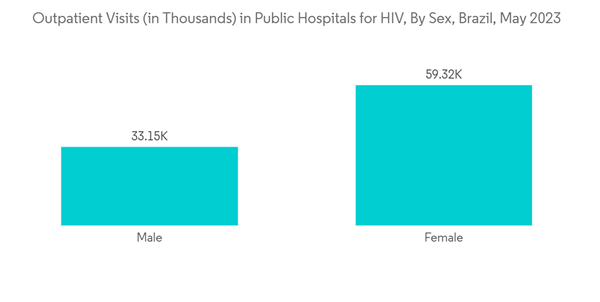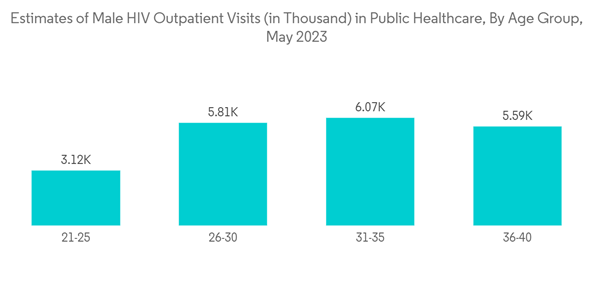Key Highlights
- COVID-19 was a global health emergency. The COVID-19 pandemic forced many companies in global contraceptive manufacturers to halt business operations for a short term to comply with new government regulations to curb the spread of the disease. This halt in operations directly impacted the revenue flow of the Brazilian contraceptive device market. For instance, in an article published in The European Journal of Contraception & Reproductive Health Care in February 2022, during the early phase, there was a decline in the use of contraceptives due to the temporary closure of clinics, and the sales of contraceptives fell during 2020. However, according to the same source, during the late pandemic, the increase in sales of the levonorgestrel-releasing intrauterine system (LNG-IUS) and etonogestrel (ENG) implant in the private sector indicated inequitable access to modern contractive methods, thereby driven the market growth. Therefore, Brazil's contraceptive devices market is anticipated to witness slow growth during the initial phase of the pandemic; however, post-pandemic, the market attained its pace and witnessed significant growth and is expected to do the same over the forecast period.
- The factors that are driving the Brazilian contraceptive devices market are the increasing incidence of sexually transmitted diseases (STDs) and a rise in unplanned pregnancies.
- Sexually transmitted infections (STIs), including Human immunovirus (HIV), syphilis, chlamydia, gonorrhea, trichomoniasis, and genital herpes, are major public health problems in Brazil. For instance, according to Brazilian Health Data, the number of outpatients in public hospitals in Brazil with unspecified HIV was 68,941in May 2023. Furthermore, according to an article published in the Journal of the Brazilian Society of Tropical Medicine in May 2021 reported the high prevalence of sexually transmitted diseases in Brazil, and there is a need for expanding access to diagnostic tests, and early treatment is crucial for controlling the spread of pathogens that cause cervicitis.
- An unintended pregnancy occurs from not using contraception or by inconsistent and incorrect use of contraceptive methods. The growth of the contraceptive market is a necessity to avoid unwanted pregnancies and their complications, especially among teenagers. For instance, in an article published in Frontiers in Public Health in April 2021, approximately 12 million adolescents aged 15-19 years, 770 thousand of whom are under 15 years, give birth each year in the developing world. Thus, high adolescent and unplanned pregnancies are anticipated to drive the market for contraceptive devices in the country. Also, governments and policymakers in the country are addressing sexually transmitted infections (STIs) among young people through high-quality sex education programs, access to clinical care, preventive technologies and vaccines, and confidential services. All these initiatives are making young people aware of sexually transmitted diseases (STDs) and thus increasing the need for contraceptive devices, thereby driving the market.
- Therefore, due to factors such as the huge prevalence of sexually transmitted diseases and rising unplanned pregnancies, the Brazil contraceptive devices market is expected to show significant growth over the forecast period. However, side effects associated with using contraceptive devices may slow down the market growth over the studied period.
Brazil Contraceptive Devices Market Trends
Condoms Segment is Expected to Witness a Significant Growth Over the Forecast Period
- Condoms are expected to witness significant growth over the forecast period. Condoms are barrier contraceptives made from latex rubber, a synthetic rubber called polyisoprene, a very thin plastic called polyurethane, or a synthetic material called nitrile. A condom is a sheath-shaped barrier device used during sexual intercourse to reduce the probability of pregnancy or a sexually transmitted infection (STI). There are both male and female condoms. Their use greatly decreases the risk of gonorrhea, chlamydia, trichomoniasis, hepatitis B, and HIV/AIDS. They also, to a lesser extent, protect against genital herpes, human papillomavirus (HPV), and syphilis. Furthermore, they are cheap and easy to use; thus, they are expected to hold a significant share of the market. Also, the rise in the adoption rates of contraceptive products among consumers is boosting the demand for condoms. Moreover, growing awareness through government initiatives, along with comprehensive sex education programs to reduce the prevalence of sexually transmitted diseases, is driving market growth across Brazil. Therefore, with the increasing rate of STDs, there will be a rapid increase in the demand for contraceptives, which ultimately drives the market.
- The high percentage of the young age population is anticipated to drive the market growth in the country. In July 2022, the Brazilian Institute of Geography and Statistics reported that the group aged 30 and over-represented 56.1% of the country's population in 2021, and the population aged less than 30 years constituted 43.9% of the population. Due to the presence of high among younger sexually active populations where chances of acquiring sexually transmitted infections (STIs) are high, the use of condoms reduces the prevalence of sexually transmitted infections (STIs) and teenage pregnancy. Also, the many government initiatives in the country are making young individuals aware of the use of condoms and the associated risks of unprotected sexual intercourse. Thus, the presence of a higher percentage of the young population in Brazil is associated with the increased use of condoms, thereby driving the studied market.
- The government in the country has introduced different campaigns and comprehensive sex education programs to improve awareness among youth and encourage them to use contraceptives to combat STDs and prevent unwanted pregnancies. For instance, in an article published in SAGE Journals published in March 2022, social marketing has been used to address a variety of health issues in the global south, including the promotion and distribution of condoms for family planning and HIV prevention. The article also reported that the government of Brazil had started promoting condoms heavily with creative and striking ads on TV, radio, and other media in response to an emerging HIV epidemic. Such awareness of condoms is anticipated to bolster the market growth due to the increased adoption of condoms to avoid STDs.
- Furthermore, according to a United Nations estimate, the number of patients living with HIV in Brazil in 2021 was 960,000. Such a huge prevalence in the country is further expected to bolster the segment due to increased adoption of condoms to avoid HIV infections.
- Therefore, the rising prevalence of STDs and rising initiatives from the government, among others, are the factors expected to drive the segment growth.
Male Segment by Gender is Expected to Hold a Healthy Growth Rate Over the Forecast Period.
- The male segment is anticipated to hold a significant share due to the rise in the adoption of male contraceptives. New, inexpensive, reversible, and safe methods of birth control can assist men in sharing responsibility for contraception with their spouses and decreasing the number of unwanted pregnancies.
- Rising awareness of male contraception is expected to drive the segment's growth. For instance, in June 2021, DKT International, a global non-profit, launched HIV test kits, improved access to contraception, and creative educational marketing efforts to support men's and couples' long-term sexual and reproductive health.
- Furthermore, to honor the LGBTQIA+ community, DKT Brazil introduced special pride edition condoms. Additionally, the nation will encourage young people to use condoms by supporting a "Prudence Party" on the well-known MTV reality TV program Holidays with Ex, which features couples of all sexual orientations and provides contraception for the contestants. Initiatives such as rising awareness will drive the growth of the segment studied due to increased adoption among men.
- Furthermore, according to the Brazil Health Data 2022, the number of outpatient appointments by men for HIV in 2022 in July, August, and September were 37429, 37486, and 37,155. Such a huge number of sexually transmitted diseases (STDs) is men making more aware of the risks associated with them, thereby increasing the demand for male contraception.
- Therefore, the high prevalence of STDs in men and the rising awareness of men's contraception are the factors expected to drive the segment growth.
Brazil Contraceptive Devices Industry Overview
The market studied is moderately competitive, and several international players are operating in Brazil's Contraceptive devices market. The factors owing to the competition include the rising strategies from the key market players to advertise their products, rising expansion, and approvals, among others. Some of the players operating in the Brazil contraceptive devices market are AbbVie (Allergan PLC), Bayer AG, Church & Dwight Co, Inc., Johnson & Johnson, Merck & Co. Inc., Pfizer Inc., Reckitt Benckiser Group plc, The Cooper Companies, Inc., and Veru Inc. (The Female Health Company).Additional Benefits:
- The market estimate (ME) sheet in Excel format
- 3 months of analyst support
This product will be delivered within 2 business days.
Table of Contents
Companies Mentioned (Partial List)
A selection of companies mentioned in this report includes, but is not limited to:
- AbbVie Inc. (Allergan PLC)
- Bayer AG
- Church & Dwight Co, Inc.
- Johnson & Johnson
- Pfizer Inc.
- Reckitt Benckiser Group plc
- The Cooper Companies, Inc.
- Veru Inc. (The Female Health Company)
- Ansell Ltd
- Merck & Co.










